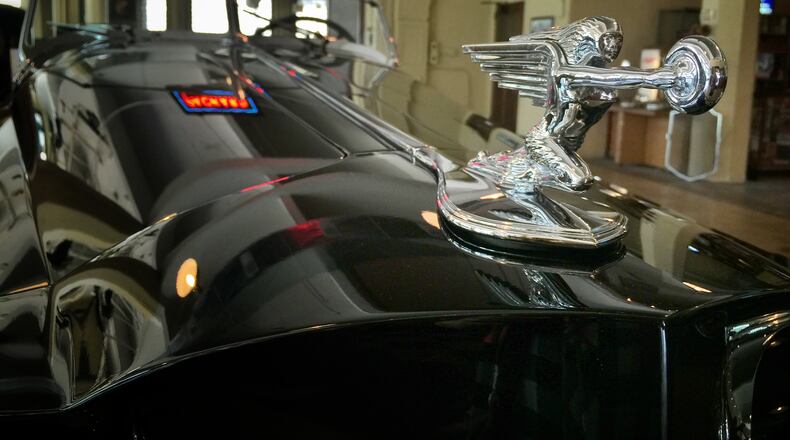Robert Signom III, son of the museum’s founding curator, said the Packard Museum has restructured operations since he stepped into the role following his father’s death in July 2019.
“The Museum has revamped its financial planning and budgetary process, made important upgrades to our collections strategy and strategic plan, while continuing to support our mission of educating present and future generations about the Packard Motor Car Company, its products and philosophies,” Signom said.
Part of the plan includes making 30 installment payments to pay off the back taxes at the museum’s Dayton location at 420 S. Ludlow St., which currently total more than $49,000 according to county property tax records.
“The tax payment plan is paid current-to-date and there is no threat to the America’s Packard Museum main campus,” he said.
The museum’s downtown properties were also in jeopardy of being foreclosed on this year due to the delinquent taxes. The museum was sent a letter by the prosecutor’s office giving it a last chance to pay the taxes or set up a payment plan, according to Montgomery Treasurer Russ Joseph.
Currently, there are about 4,500 parcels in Montgomery County whose owners are on delinquent payment plans. About 4,000 are residential properties and 425 are commercial. The rest include a mix of agricultural, industrial and about 15 properties owned by nonprofits, which could be paying off assessments, back taxes from before a property became exempt, or regular taxes on property not utilized for non-profit purposes, according to the treasurer’s office.
The America’s Packard Museum’s three-building main campus showcases more than 50 automobiles. Visitors enter through an original Packard dealership — The Citizens Motorcar Company — constructed in 1917. The museum also features many related artifacts and houses the Robert and Sonia Turnquist Packard Library, a repository of Packard literature.
The organization, however, will let two adjacent properties on Ome Avenue in Harrison Twp. slip into foreclosure, Signom said. One includes six attached buildings comprising roughly 11,000-square-feet of warehouse space, according to the county auditor.
“The Ome Avenue properties were determined surplus to the museum’s needs and not necessary to the museum’s mission or vision,” Signom said. “The museum attempted to find an interested buyer for these properties and worked with the Montgomery County Land Bank before this action was taken, but with little success.”
The Ome Avenue properties were donated to the museum in 2011 to use for storage. In 2015, the warehouse space became the target of arsonists, Signom said. According to the tax foreclosure complaint filed this week in Montgomery County Common Pleas Court, $133,820.99 is owed in taxes, assessments, penalties and interest.
About half the taxes due at the main campus are the result of special assessments. The remainder is property tax levied on an outbuilding and office space his father used for his law practice until 2017, Signom said.
“There was a time when correcting this issue was not of the highest priority, but now it is,” he said. “We feel that our responsibility to our community is greater now than ever and we want to do our part of the work to show that we understand that.”
Though he’s been on the board of the museum for 20 years, his father’s death “reactivated” his commitment to the museum, said Signom, who lives in New York but spends about a week a month in Dayton.
“After putting in a significant amount of work to help the museum grow and thrive, I feel very strongly about staying for many years to come,” he said. “And it’s my understanding that the Board of Trustees feels that way as well.”
The coronavirus pandemic impacted all museums, halting the flow of visitors and events that museums rely on to cover costs. America’s Packard Museum counted between 12,000 and14,000 visitors in pre-pandemic years and hosted 80-100 events annually. Closed since March, America’s Packard Museum board considered reopening in October but held off, Signom said.
“When Ohio had a second major spike in daily cases, we felt that as much as we love what we do, educating people and sharing the collection with the community … it was not responsible for us to open,” he said. “That’s been difficult in terms of keeping our income stream alive and well. We have found help from some of our continuing supporters. Not having income from events and rentals has also been difficult.”
Work on the museum hasn’t stopped during the pandemic, Signom said.
The Art Deco showroom, which can seat 150 guests, was repainted. New heating units were installed in the Packard Pavilion building, which can host up to 225 people for events. The museum is also working toward a permanent, 5,000-square-foot exhibit to highlight Packard Motorcar Company’s contributions to winning last century’s world wars, which included manufacturing alloy engines for ships and aircraft.
“But we have a long way to go,” he said.
Signom said the part of the museum’s long-term plan is to rely less on “at the door” funds and move toward a philanthropic income model, having initiated a capital campaign to reach out to donors and supporters.
“We really believe that the museum will be around for more than the next generation,” he said. “And to do that we need to invest in the museum now, especially in terms of buildings and grounds, and by reimagining our position in the Dayton community and the national historical automobile community.”
About the Author

